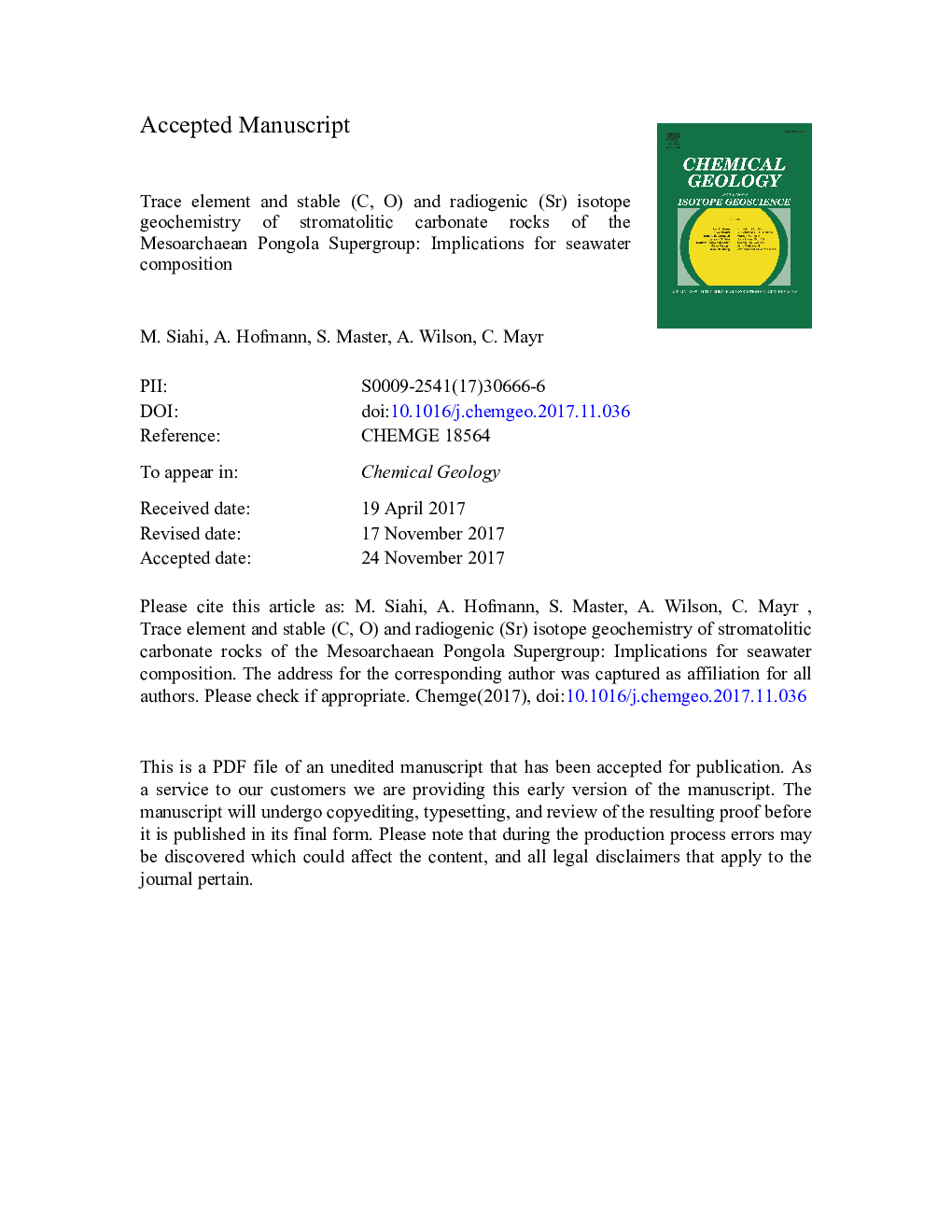| کد مقاله | کد نشریه | سال انتشار | مقاله انگلیسی | نسخه تمام متن |
|---|---|---|---|---|
| 8910481 | 1637498 | 2018 | 53 صفحه PDF | دانلود رایگان |
عنوان انگلیسی مقاله ISI
Trace element and stable (C, O) and radiogenic (Sr) isotope geochemistry of stromatolitic carbonate rocks of the Mesoarchaean Pongola Supergroup: Implications for seawater composition
دانلود مقاله + سفارش ترجمه
دانلود مقاله ISI انگلیسی
رایگان برای ایرانیان
کلمات کلیدی
موضوعات مرتبط
مهندسی و علوم پایه
علوم زمین و سیارات
ژئوشیمی و پترولوژی
پیش نمایش صفحه اول مقاله

چکیده انگلیسی
The Mesoarchaean Pongola Supergroup hosts one of the oldest well-preserved stromatolitic carbonate successions. Major- and trace-element geochemistry along with C, O, and Sr isotopic analyses of three stratigraphic sections of stromatolitic carbonate rocks were undertaken in order to infer the depositional environment, and to unravel the chemical characteristics of contemporaneous seawater. The carbonate rocks consist mainly of dolomite and, to a lesser extent, ankerite. Their variable Sr concentrations of ~ 95 to 450 mg/kg are interpreted as resulting from early to late dolomitization of metastable carbonates (aragonite and/or high-Mg calcite), facies control and calcitization during meteoric diagenesis. δ18O values range from â 19.6 to â 12.0â° VPDB and reflect recrystallization of carbonates caused by high water-rock interactions during diagenesis and metamorphism. A δ13C value of 2.5â° VPDB was measured in carbonate samples least affected by alteration, and we suggest that it approximates the composition of dissolved inorganic carbon in coeval seawater. The samples display variable 87Sr/86Sr isotopic ratios, from as low as 0.708 to 0.777. These ratios are considerably higher than those expected in Archaean open-ocean water masses buffered by hydrothermal interaction with the mantle. We interpret the highly radiogenic Sr isotopic ratios in some carbonate samples to reflect isotopic exchange with radiogenic Sr from siliciclastic/volcaniclastic components in the samples and fluids from clay-rich layers intercalated with the carbonates. The least radiogenic Sr isotopic ratio may approximate the mixed isotopic composition of seawater in the epicontinental basin and of riverine freshwater draining the Kaapvaal Craton. The dolomitic carbonate samples show shale-normalized rare earth element and yttrium distribution patterns that resemble those of modern ocean water with positive LaSN, GdSN and YSN anomalies, superchondritic Y/Ho ratios, a small negative CeSN anomaly and depleted light rare earth elements relative to the heavy rare earth elements. These anomalies are not as pronounced as expected for an open marine setting, which together with the Sr isotopic results support a more restricted setting with riverine input and fluctuations in marine ingressions. A convex-upward shale-normalized rare earth element and yttrium pattern is probably a result of several factors, including organic matter complexation, and element fractionation during estuarine mixing. The small negative CeSN anomaly may suggest small amounts of free oxygen in shallow waters due to local oxygenic microbial activity.
ناشر
Database: Elsevier - ScienceDirect (ساینس دایرکت)
Journal: Chemical Geology - Volume 476, 5 January 2018, Pages 389-406
Journal: Chemical Geology - Volume 476, 5 January 2018, Pages 389-406
نویسندگان
M. Siahi, A. Hofmann, S. Master, A. Wilson, C. Mayr,